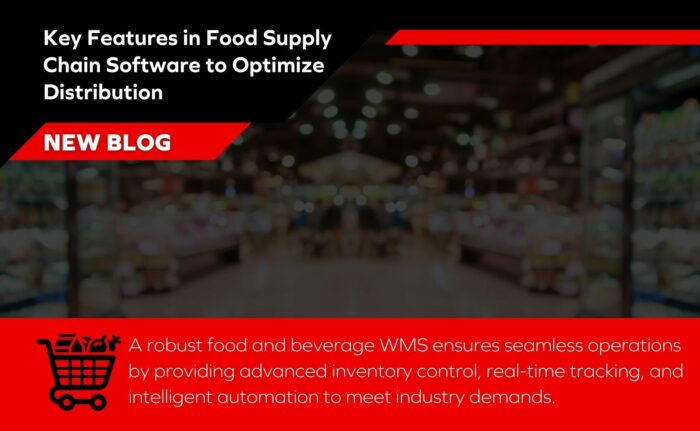
Reliable and efficient supply chain operations are essential for success, and for many, a cloud-based warehouse management system (WMS) is the key to achieving it. Although “Cloud WMS” and “SaaS WMS” (Software-as-a-Service warehouse management system) are often used interchangeably, they’re not quite the same. These terms refer to different aspects of technology and software delivery. Understanding this distinction and all the features and benefits offered by Cloud and SaaS is crucial when evaluating warehouse management systems.
To truly understand the nuances of SaaS WMS, this article will cover:
- What is a SaaS WMS?
- How does a SaaS WMS work?
- Why do I need a SaaS WMS?
- What are the benefits of a SaaS WMS?
- What are common challenges when selecting a SaaS WMS?
- What are the most important features of a SaaS WMS?
- How does SaaS WMS compare to other wms systems?
- How to choose the right SaaS WMS for your business
What is a SaaS WMS?
A SaaS-based WMS is a cloud-based warehouse management system delivered via the internet on a subscription basis. Hosted and managed by the provider, it allows users to access the software through a web browser or app. Designed for businesses operating in a fast-paced, competitive market, a SaaS WMS enhances efficiency, flexibility, and scalability.
How does a SaaS WMS work?
Unlike traditional WMS solutions, a SaaS WMS optimizes and automates warehouse operations with minimal IT overhead. It streamlines key functions such as inventory management, order fulfillment, receiving and putaway, shipping, labor management, reporting, and integrations with other software. Its cloud-based nature enables automatic updates, seamless scalability, and enhanced accessibility. With these advantages in mind, how can businesses determine if a SaaS WMS is the right fit for them?
Why do I need a SaaS WMS solution?
A SaaS WMS offers key advantages, with adaptability and scalability being among the most critical. As Steve Pullo, Executive Vice President of Professional Services at Made4net, explains, “Cloud technology allows businesses to quickly adjust to changing demands, seamlessly support multiple channels, and integrate with robotics and automation. By leveraging the cloud, companies can enhance operational efficiency, improve flexibility, and stay competitive in a rapidly evolving market.” However, determining whether a SaaS WMS is the right fit requires a deeper understanding of its full range of benefits.
What are the benefits of a SaaS WMS solution?
By leveraging cloud-based technology, a SaaS WMS provides greater flexibility, enhanced real-time visibility, and advanced automation tools that streamline operations. These capabilities help businesses increase efficiency, reduce errors, and ultimately improve customer satisfaction. Let’s explore these benefits in more detail.
SaaS WMS Benefit #1: Agility
Responding to market demands in a timely fashion is no longer a luxury, but a necessity. A Cloud-based system like a SaaS WMS empowers operations to respond to market fluctuations with agility and precision.
SaaS WMS Benefit #2: Operational efficiency
By automating routine warehouse processes like order picking, packing, and shipping, a SaaS-based WMS reduces human error and speeds up operations, improving overall efficiency.
SaaS WMS Benefit #3: Cost savings
A SaaS-based WMS doesn’t incur a significant investment up front since it operates on a subscription basis. As such, operations can gain access to its benefits without having to pay for hefty up front costs for software, hardware, and infrastructure.
SaaS WMS Benefit #4: Flexibility and scalability
Responding to seasonal demands and the peaks and valleys of the market is easy with a SaaS-based WMS. The system can be adjusted based on demand, so you’re only paying for what you use. Without hardware and infrastructure needs, a SaaS-based WMS is easy to scale as your business grows.
SaaS WMS Benefit #5: Automatic Updates
Automatic software updates means operations have access to the latest features, security patches, and compliance requirements without manual intervention.
SaaS WMS Benefit #6: Accessibility
By offering access from any internet-connected device and supporting mobile features like barcode scanning, order tracking, and real-time updates, a SaaS-based WMS empowers operations and employees to work smarter.
SaaS WMS Benefit #7: Integrations
Other enterprise software solutions, such as ERPs (Enterprise Resource Planning), CRMs (Customer Relationship Management), and TMS (Transportation Management Systems) can easily integrate with a SaaS-based WMS, fostering a more connected and efficient supply chain.
SaaS WMS Benefit #8: Reduced IT maintenance
Without the need for internal IT infrastructure, the responsibility of maintaining the server, security, and backups falls to the software provider, freeing up internal IT resources to focus on other priorities.
SaaS WMS Benefit #9: Data security and disaster recovery
Depending on the vendor, SaaS-based WMSs offer strong and reliable security measures, with built-in disaster recovery solutions and data backups maintained by the provider.
SaaS WMS Benefit #10: Improved customer satisfaction
Real-time insights and more efficient operations lead to faster order processing and shipping, which improves customer satisfaction.
Whether you’re a small business looking to scale or a larger enterprise seeking more agility, a SaaS WMS can be a game-changer for your supply chain.
What are common challenges when selecting a SaaS WMS solution?
While SaaS WMS offers many benefits, such as faster deployment and lower upfront costs, there are challenges that must be carefully considered when selecting a SaaS-based WMS.
- Integration Complexity: While many SaaS providers offer built-in APIs and integration tools, ensuring smooth data flow and compatibility with your existing infrastructure still requires careful planning and testing.
- Disruption: While these systems are typically designed for quicker deployment, a well-structured plan is needed to minimize downtime and ensure that daily warehouse operations continue with minimal interruptions.
- Data accuracy: Since a SaaS-based WMS relies on real-time data for tasks like inventory management and order fulfillment, any data integrity issues can lead to inefficiencies and errors. Ensuring that data is entered correctly and synced across all systems is vital to prevent inaccuracies.
- Cost: Although SaaS-based WMS solutions are typically more affordable upfront than on-premise systems, the ongoing subscription costs can add up over time. It’s important to evaluate the long-term cost relative to the benefits, considering factors such as system features, scalability, and potential hidden fees for additional functionality or usage.
- Scalability: Understanding how well the solution can scale to accommodate future growth is crucial. This includes increased product volumes, new warehouse locations, and evolving technological needs. Ensuring the system can grow with your business without significant additional costs or complexity is key.
What are the most important features of a SaaS WMS?
The features of a SaaS-based WMS all come together to create a system that addresses individual warehouse needs with meticulous attention to detail. These features do more than improve operational flow, they supercharge them for success.
SaaS WMS Feature #1: Integration
By integrating with other integral software systems, a SaaS-based WMS fosters an ecosystem of productivity within your operations. For example, the combination of an ERP and a WMS gives operations an in-depth look at front- and back-office operations, ensuring all departments are on the same page.
SaaS WMS Feature #2: Visibility and Inventory Management
A SaaS-based WMS provides real-time updates on stock levels, order statuses, and shipment tracking, enabling operations to make data-driven decisions and avoid stockouts or overstocking. It also allows businesses to quickly respond to unexpected market changes, staying proactive rather than reactive.
SaaS WMS Feature #3: Customization
No two businesses are the same, each with a unique set of requirements to operate efficiently. A SaaS-based WMS is designed with customization in mind, allowing businesses to adapt the system to their specific needs without requiring a heavy IT lift. With no-code/low-code capabilities, users can modify workflows, create custom reports, and set specific user permissions—whether managing palletized shipments or handling perishable goods. This flexibility ensures that the WMS aligns with operational demands while remaining agile and easy to update as needs evolve.
How does a SaaS WMS compare to other WMS systems?
Compared to on-premise systems, SaaS WMS offers a subscription-based, flexible approach that enables businesses to adapt quickly to market changes without the burden of maintaining hardware or software. For companies looking to future-proof their operations, SaaS WMS presents a compelling alternative with built-in agility and cost-efficiency.
How to choose the right SaaS WMS solution for your business
With so many different options to choose from, it can be difficult to know which SaaS-based WMS is best for your needs. That’s why careful research is a critical step in the selection process. One of the best ways to get started is by consulting the latest Gartner® Magic Quadrant™ for Warehouse Management Systems. The research in the report offers a great way to gain an understanding of the current state of the WMS market.
The important thing to remember is that the best WMS for you isn’t necessarily the one that is most touted by research, instead, it’s the one that most effectively tackles the unique challenges of your warehouse operations. To find the right SaaS-based WMS, start by:
- Defining business requirements
- Gathering stakeholder input, including from the warehouse team, the IT group, and executive leadership
- Outlining what responsibilities your operation can take on, and which will need to be outsourced to the WMS vendor
- Conducting thorough research
- Narrowing choices down to a shortlist
- Developing an extensive RFP, being sure to plan for future growth needs
- Requesting demonstrations, being sure to test how the system works through exceptions that may slow you down, not just the “happy path”
Choosing a SaaS-based WMS is a significant undertaking, so take the time to make an informed decision that will benefit your business for years to come. If you’re ready to explore SaaS WMS options, start by evaluating your current needs and consulting industry research—or reach out to our WMS experts.


